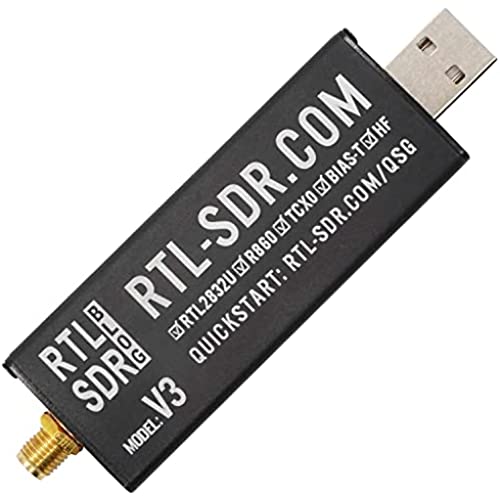

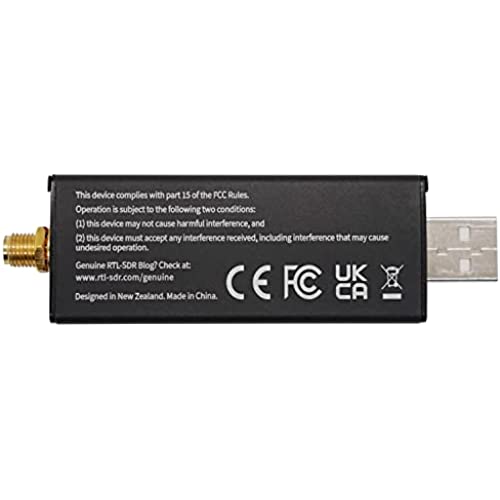
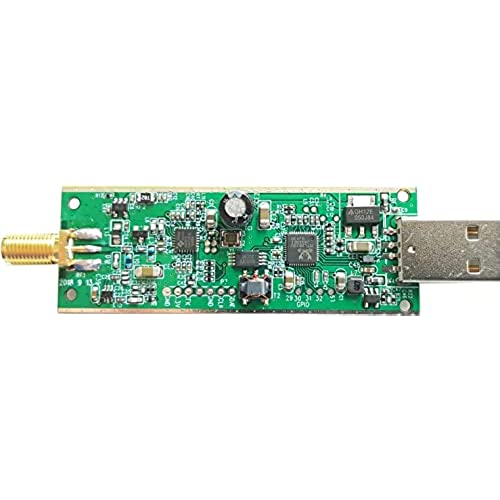
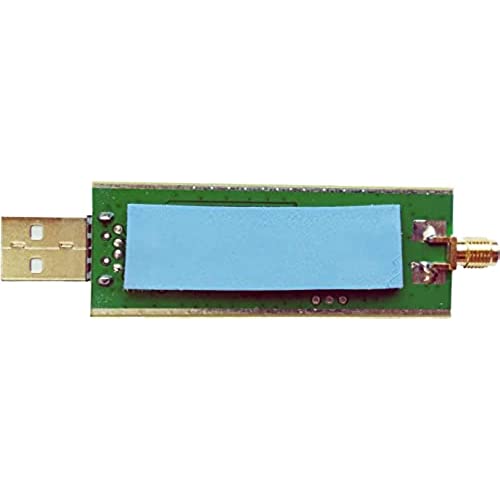
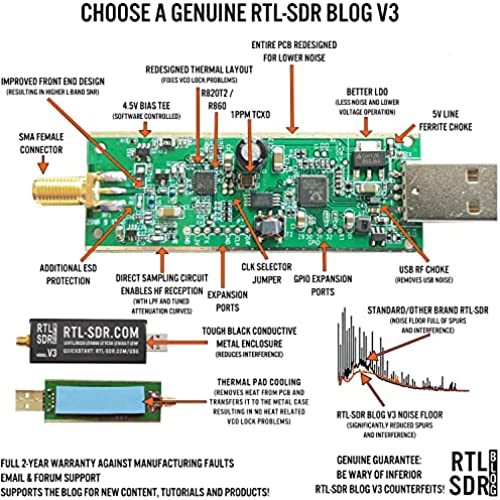
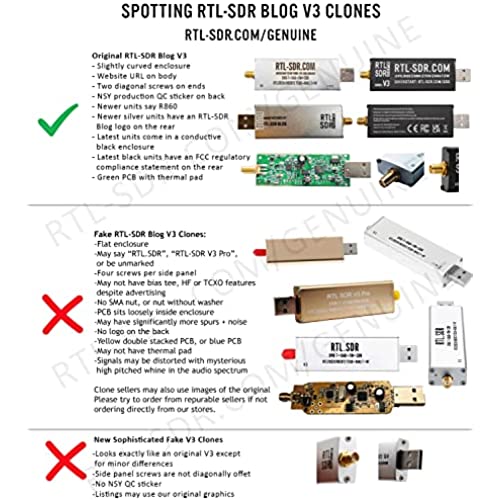







RTL-SDR Blog V3 R860 RTL2832U 1PPM TCXO SMA Software Defined Radio (Dongle Only) (Black)
-

LLK
> 24 hourI ordered one of these and spent hours and hours over several days trying to get it to work. I figured that, with all the positive feedback, it must be something that I was doing wrong, in spite of following the Quick Start Guide to the letter. I finally threw in the towel and sent it back for a refund. But I kept thinking about it, so I ordered another one, determined that I was going to figure this thing out. Im glad I did, because I was up and running in 15 minutes with the second one, and Ive been having fun with it ever since. The first one I received was obviously defective. If you follow the instructions, and it doesnt work properly, dont waste a lot of time trying to troubleshoot it. Send it back for a replacement. I took off one star for the lack of quality control. Had the first one worked, I would have rated it 5 stars.
-

Max Oldham
> 24 hourI give it 5 stars for being exceptionally high value. Im not saying its the greatest radio receiver - it takes considerable tweaking to get it to do what I want. But for the money...it receives FM music stations, ham and local emergency team communications, and I suppose it will receive weather, police, and maritime activity once I get that programmed in. So far Im mainly using it with the software called HDSDR - I get slow waterfall displays that show traffic activity across a range of frequencies, say 2 MHz wide, with a single image showing activity during say 1/2 hour. For finding vacant channels to use for 2-way communications without interference by others, I think this will be much better than using a regular scanner.
-

Ron
> 24 hourThe SDR if loaded with features and worked flawlessly with my windows 8. You will need a good antenna for get the most out of this and expect a learning curve to move beyond the very basic features. Lots of info available on the web. Very satisfied.
-

Remington
> 24 hourWorks really well - though probably would benefit from a high-pass filter to block strong AM stations, Im not having an issue. For the price, it performs well and can absolutely use it as a competent general-coverage receiver. I have an older version with the Noo-Elec ham-it-up up-converter, and had planned to use the up-converter with this, but found the up-converter introduces some birdies at a few of my favorite 75-meter frequencies. So I use this with SDR-sharp software in direct Q-branch sample mode so I can receive HF without the upconverter. One problem with that is Ive found it difficult to find and use other SDR software with more features than SDR sharp (like a notch filter, lacking in SDR-sharp). Other SDR software seems to lack the direct-sample mode. Im still looking though. For the price, and simplicity, this is a fantastic product and I highly recommend for someone interested in getting into software-defined radio.
-

Ira Richmond
> 24 hourIt works, but...it is mainly designed for the VHF and UHF range of 24Mhz and up. While, yes, it can receive HF, its effectiveness at receiving those frequencies isnt very high. On the HF band, its about as sensitive as a cheap $20 shortwave analog radio with a short whip antenna. If you want to get it for scanner purposes or for anything regarding ham radio in the 144 or 440Mhz range, then this will do fine as long as you get the kit with the antennas in it. I cannot recommend this for shortwave or HF ham radio band listening. With that said, let me say this, for just $20 or so this would be a decent way to give someone a dip into the Software Designed Radio waters. To give them an idea of what is possible with an SDR, what it can pick up, and what it can do with the right software. For Linux users: I run Ubuntu 18.04LTS and this was pretty much plug and play for me. All I had to do was install CubicSDR from the Ubuntu Software Center, plug in the dongle, and it started receiving. I couldnt get GQRX to work with this dongle at all on the HF bands. It worked just fine with CubicSDR. But like I said above, this is about as sensitive on the HF bands as a cheap analog shortwave radio. Thus is why Im returning it. It was a nice experiment into the SDR realm and give me a taste of the possibilities. However, I think Ill stick with actual hardware receivers and use an audio connection for decoding. That Im already doing.
-

bob g
> 24 hourpretty cool little bugger, never used one before so i am still learning be aware they run hot, not hot enough to burn your fingers or anything, but one might think something is wrong when that is just how hot they are in operation. i bought a ham it up unit to down convert so that i could receive sw and ham bands below 25mhz along with the AM broadcast bands, without which this unit does not have the ability to resolve. also have to download the drivers and software to make it work on your computer, i use it with windows 10 and youtube smokingape or smokinape is your friend when it comes to getting this thing running. i am using it with a 9:1 balun and a 30ft long wire antenna inside so it is not at all optimal, but it seems to work for proof of operation. my next move will be getting a better antenna and mounting it outside. my use will be in the shortwave bands. so far it is great on the FM broadcast band, and with my poor antenna ok on AM broadcast, and somewhat works on shortwave below about 11mhz or so... i think the antenna is the shortfall. i would recommend it to anyone wanting to try an sdr
-

JW
> 24 hourThese are all the rage on youtube but my experience is quite different. I can pick up local FM stations just fine. If I am very careful, I can sometimes pick up the local NWS transmitter located 8-miles from my home – almost line-of-sight to the transmitter. The device does not show signals that I can clearly pick up from security services near my home using a Baofeng HT. Beyond that, this is a great collector of spurious interference. It has been the same across two devices (I thought I received a dud, so I bought another) and across three computer systems with many connection types. There is no difference when it comes to antennas either. I used several amateur UHF/VHF and HF antennas with identical results. It might be more cost-effective to just purchase a cheap scanner or SW receiver for your listening needs. Don’t waste your time or money on these items.
-

Joe
> 24 hourHave bought other SDR and DVB/DAB dongles and so far this is the best one. Gets hot with use. Would like to have better contact with a heat sink or some holes to circulate air in the dongle to keep it cooler. Very accurate ppm, worst dongle I have is -2.2 ppm off frequency. Definitely worth the buy if you want to use this at home as a hobby or need to get into the scene at a reasonable price.
-

Paul M Elliott
> 24 hourIm using this SDR at 10 MHz (ham band digital modes receiver), and with an external antialiasing filter / preamp it works quite well. As expected, without the filter the 28.8 MHz sample clock gives us some textbook aliased images above 14.4 MHz. Im also using this SDR at 162 MHz (marine AIS) and it does well. I am also using a filter / preamp to improve the strong-signal rejection and desired-signal sensitivity. The frequency accuracy and stability are quite reasonable. Ive got about five of these running now and they all work well. There are better-performing SDRs for 4X the price (or more), but the bang for the buck on this one is hard to beat.
-

Phantasm
> 24 hourThis is the real deal. Not a fake or clone.
